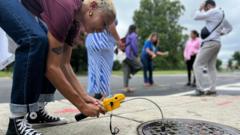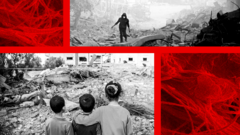Community volunteers and advanced satellite technology converge to tackle methane emissions, aiming to enhance air quality and combat climate change.
**Crucial Innovations in Methane Detection: Community Efforts and Satellite Solutions**

**Crucial Innovations in Methane Detection: Community Efforts and Satellite Solutions**
Citizen scientists and cutting-edge technology unite to address methane emissions in urban communities.
In Washington D.C., a network of community volunteers and eco-activists has taken to the streets and homes to evaluate air quality, specifically targeting the elusive yet hazardous methane gas. Armed with handheld sensors resembling walkie-talkies, these citizen scientists are revealing the concealed presence of methane, a potent greenhouse gas responsible for a significant portion of global warming. Over a recent 25-hour survey, several outdoor leaks were identified, alarming researchers about the potential health impacts, particularly asthma, among local children.
Methane, while invisible and often undetectable, is primarily emitted from fossil fuel extraction, agricultural practices, and waste management. The community's findings, verified by healthcare leaders like Djamila Bah of Action in Montgomery, have raised significant red flags, as approximately one in three children from the monitored households suffers from asthma linked to gas exposure.
Recent technological advancements have improved methane detection, moving from handheld sensors to sophisticated satellite systems. The Tanager-1 satellite, launched in August 2024, along with initiatives like the Environmental Defense Fund's MethaneSAT, is enhancing our ability to track both major emitting incidents and smaller, widespread sources. Riley Duren from Carbon Mapper highlighted the impressive capacity of Tanager-1 to navigate challenging environments, enabling more accurate identification of methane releases.
Despite the progress made with satellite emissions tracking, the challenge remains in translating data into effective mitigation actions. The Methane Alert and Response System (MARS) demonstrates this ongoing struggle; while over 1,200 alerts for significant methane leaks were generated, only a fraction prompted responses. However, environmental specialists, including Itziar Irakulis Loitxate from the International Methane Emissions Observatory, express optimism that improved communication will yield better engagement and more proactive measures from companies.
At the grassroots level, sharing and analyzing air quality data empowers local residents to address misconceptions about air pollution. Joelle Novey from Interfaith Power and Light emphasizes the value of informed communities: "Now that we know better, we can do better." As technology continues to evolve, a harmonious blend of community action and advanced monitoring will be crucial in combating methane emissions and promoting healthier environments for all.
Methane, while invisible and often undetectable, is primarily emitted from fossil fuel extraction, agricultural practices, and waste management. The community's findings, verified by healthcare leaders like Djamila Bah of Action in Montgomery, have raised significant red flags, as approximately one in three children from the monitored households suffers from asthma linked to gas exposure.
Recent technological advancements have improved methane detection, moving from handheld sensors to sophisticated satellite systems. The Tanager-1 satellite, launched in August 2024, along with initiatives like the Environmental Defense Fund's MethaneSAT, is enhancing our ability to track both major emitting incidents and smaller, widespread sources. Riley Duren from Carbon Mapper highlighted the impressive capacity of Tanager-1 to navigate challenging environments, enabling more accurate identification of methane releases.
Despite the progress made with satellite emissions tracking, the challenge remains in translating data into effective mitigation actions. The Methane Alert and Response System (MARS) demonstrates this ongoing struggle; while over 1,200 alerts for significant methane leaks were generated, only a fraction prompted responses. However, environmental specialists, including Itziar Irakulis Loitxate from the International Methane Emissions Observatory, express optimism that improved communication will yield better engagement and more proactive measures from companies.
At the grassroots level, sharing and analyzing air quality data empowers local residents to address misconceptions about air pollution. Joelle Novey from Interfaith Power and Light emphasizes the value of informed communities: "Now that we know better, we can do better." As technology continues to evolve, a harmonious blend of community action and advanced monitoring will be crucial in combating methane emissions and promoting healthier environments for all.





















